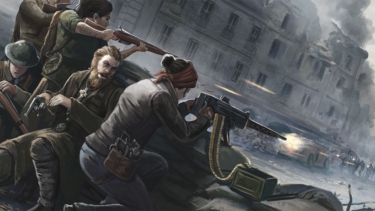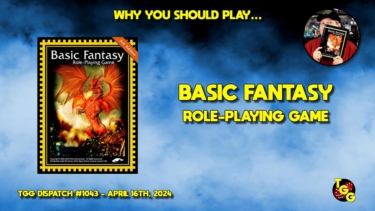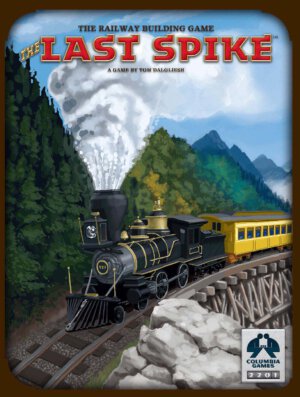
Publisher: Columbia Games
Designer: Tom Dalgliesh
Year: 2015 (Originally published in 1976)
Genre: Economic railroading tile placement
Players: Two to six players
Ages: 10+
Playing Time: 30 – 90 minutes
MSRP: $39.98
It’s rare I get a chance to review a Columbia Game title so when the opportunity arises I’m a happy camper, since I’ve yet to ever run across a dud. While Columbia is best known for their lineup of historical wargames they also publish non-grognard related titles such as Slapshot and the Hârn Roleplaying game series. The Last Spike (originally released in 1976) is another entry which doesn’t deal with conflict simulation and Grant Dalgliesh, alongside the team at Columbia, has polished up the classic game for a whole new generation.
I’m one of these full discloser sorts so it’s best I begin this review by mentioning I don’t play a lot of railroad related games. Funny enough, the ones I’ve played I’ve mainly enjoyed and you’ll notice I’ve reviewed a few I liked a lot too. My buddy Luis Montes in Arizona was always trying to get me to sit down and play his favorite game, Martin Wallace’s Steam, yet it never happened. I suppose when I’m thinking about what sort of game I’d like to play next the railroad genre isn’t what first (or fifth) pops into my head.
Ok, I know 18xx fans will now want to burn me in effigy so go ahead and pop over to my bio, print out the photo, and grab a match. I’ll wait.
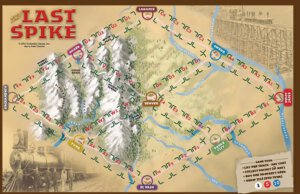
Upon opening the box we’re treated once again to solid Columbia components. Blocks represent sections of track and stickers, with various track costs, will need to be attached to the blocks. Also included are wooden disk in white, red, and blue which represent $1000, $5000, and $10,000. Small decks of cards for each city on the map represent land deeds that players purchase through the game. Lastly, there’s the rule book and the map showing different routes which can be built. I have to mention the one thing really lackluster in the production is the map. For some reason it’s of a different material than the game boards usually included in Columbia Games (or at least the handful I own) and it’s sort of a crappy cardboard. At the price point of the game I can understand not having a mounted map but I’ve seen better paper maps in titles half the price.
The gameplay of The Last Spike is very easy to get into and takes, at most, about ten minutes to teach. Each player is looking to work with the others in order to complete a route from St. Louis to Sacramento. The wannabe robber barons will cooperate to a certain extent, by connecting various cities by rail, while also aiming to finish with the most cash in hand.
Setup is pretty quick as you’ll lay out the map and sort the various city land deed card by color and cost; as more land is bought the price increases. Then the players each draw a random rail tile to determine who will go first as the closest tile designation to A1 gets to initiate the proceedings. You’ll follow that up by mixing all the files face down and having everyone select four rail tiles as their starting supply. Personally, I used a good sized draw string dice bag for the tiles 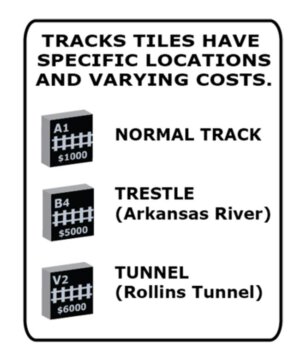
Note all tiles are kept hidden from everyone else (you can also hide your money) but land deeds are always kept face up on the table so who owns what land is common knowledge.
Each of the players take turns performing the following:
Pay to build and lay a track tile – Each turn you’ll have to lay a tile to move railroad construction along. Each tile has a unique number and letter which corresponds to a space on the board. The tiles also have a cost associated with them which needs to be paid in order to build. Track tiles have to be built next to a city or another track tile already on the map. If the active player can’t meet either of those requirements they still have to build track and have to pay double the cost.
Payouts also take place whenever a route between two cities is completed. Any players who own land deeds for the two connecting cities receive cash based on the number of deeds they own. Also, as a bonus, the first person who lays a tile next to a city gets to claim the free land deed for that particular city.
Optionally buy a land deed – Although not required, the active player can decide to purchase one land deed from a city which has had a free land deed claimed. If the active player received a freed deed then they may not buy one that turn. As more deeds are purchased the cost of that city’s land increases.
Draw a new tile – The turn ends by picking a new rail tile and then the next person begins their turn.
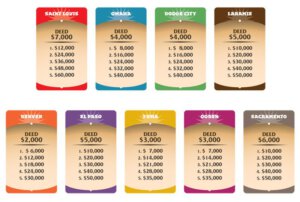
The turns continue until a tile is laid which completes a connection between St. Louis and Sacramento. Whoever laid that final tile is considered to have driven in the proverbial “last spike” and receives a $20,000 bonus. All monies are tallied up and the player with the most cash is declared the winner. Remember, it’s all about the cash and not land deeds and value. The total cost of land deeds held is the tie breaker.
While The Last Spike is mainly a game of economic tile laying it can be enjoyed on a couple of levels. The game works quite well as a light family game where everyone is working together to build that railroad and the winner just happens to be the one with the most dough at the end. Folks around the table are happy because the railroad was finished.
You can also tackle the game in a much more strategic way (although it’s a rather light strategy title) because you never know who has what unplayed tiles. The only available indicator of what anyone else is planning is the land deeds someone owns, because those cards are always visible on the table. If someone is investing heavily in deeds from a particular city then it’s a good bet they’ll be trying to connect the city to another. If you happen to be flush with cash it’s even possible to buy land, and lay a tile near that city, knowing full well you have no interest in the railroad passing through there. You just made the move to possibly start a rush of land speculation for that city. Of course, that can also seriously backfire on you too!
The Last Spike doesn’t involve a whole lot of player interaction because, in essence, you’re playing the tiles you’ve drawn and making the best of what you’ve got. You aren’t playing in a vacuum either since whatever you might do in any given turn will affect everyone else’s moves after, be it by them laying tiles next to yours or buying deeds. There isn’t anything in the rules against negotiating with others about teaming up to connect cities either.
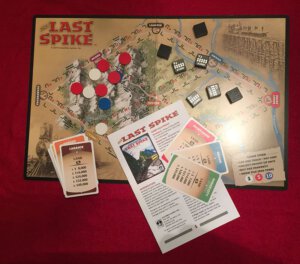
I think The Last Spike is a blast and can see it appealing to players and families who enjoy a bit of lighter fare. Once you’ve got the rules down pat even a four player game can finish in a little over thirty minutes since turns fly by rather quickly. Honestly, I know it isn’t going to be of interest to diehard 18xx gamers but that’s not the intended audience anyway. I understand the sorts of titles that crowd gets excited about and, frankly, this isn’t it. Yet for those who are looking for an entertaining game, that’s equally accessible to your usual ten year old as well as your non-gaming fanatic spouse, The Last Spike is highly recommended. Yes, even with the sort of crappy game board.
And, seriously, I’m dinging the final review score a touch for the board. Really.
- Paizo Inc Reveals the Pathfinder: War of Immortals Mega Event - Apr 18, 2024
- Campaign Builder: Dungeons & Ruins Funds in First Kickstarter Minutes - Apr 18, 2024
- They Came From the Cyclops’s Cave! is Out in Print and PDF - Apr 18, 2024










